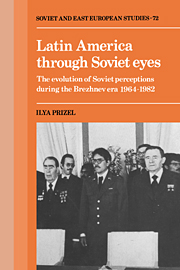 Latin America through Soviet Eyes
Latin America through Soviet Eyes Book contents
- Frontmatter
- Contents
- Preface
- Acknowledgments
- Introduction
- Part I Soviet perceptions of Latin America's global role
- Part II Soviet perceptions of Latin American social structures
- Introduction
- 6 The Latin American church
- 7 The Latin American armed forces
- 8 Latin American labor unions
- 9 Bourgeois political parties
- 10 Wars of national liberation or peaceful transformation?
- Part III Soviet–Latin American relations during the Brezhnev era
- Part IV Conclusion: the emerging Soviet perception of Latin America and the future of Soviet policy toward the hemisphere
- Conclusions
- Epilogue – Latin America: the Long March
- Notes
- Bibliography
- Index
10 - Wars of national liberation or peaceful transformation?
Published online by Cambridge University Press: 05 February 2012
- Frontmatter
- Contents
- Preface
- Acknowledgments
- Introduction
- Part I Soviet perceptions of Latin America's global role
- Part II Soviet perceptions of Latin American social structures
- Introduction
- 6 The Latin American church
- 7 The Latin American armed forces
- 8 Latin American labor unions
- 9 Bourgeois political parties
- 10 Wars of national liberation or peaceful transformation?
- Part III Soviet–Latin American relations during the Brezhnev era
- Part IV Conclusion: the emerging Soviet perception of Latin America and the future of Soviet policy toward the hemisphere
- Conclusions
- Epilogue – Latin America: the Long March
- Notes
- Bibliography
- Index
Summary
Although the preponderant power of the United States in Latin America played a pivotal role in forming the Soviet perception of the region, and indeed often influenced the extent of Soviet willingness to become involved in the hemisphere's affairs (either itself or through Cuba), it was nevertheless the perception of the domestic correlation of forces that ultimately determined the Soviet prognosis of Latin America's political future. The usual Western analysis of changing Soviet attitudes, which correctly identifies the time periods involved, is weak in that it assigns primary importance to external forces acting on Latin America rather than to regional domestic realities. Thus, the course of Soviet attitudes is characterized as follows: (1) Between 1960 and 1962, when the USSR – buoyant, due to the Cuban revolution – expected a rapid repetition of similar wars of national liberation throughout the region. (2) Between 1962 and 1968, when the USSR was chastened by the confrontation with the United States during the Cuban missile crisis and consequently abandoned the notion of wars of national liberation in Latin America but continued to express verbal support (so as not to be upstaged by China as the world leader of the left). (3) Between 1968 and 1980, when the USSR, no longer concerned by the Chinese challenge and far more interested in détente with the United States, cracked down on Castro's efforts to “export revolution” and downplayed its belief in the viability of wars of national liberation.
- Type
- Chapter
- Information
- Latin America through Soviet EyesThe Evolution of Soviet Perceptions during the Brezhnev Era 1964–1982, pp. 135 - 148Publisher: Cambridge University PressPrint publication year: 1990
